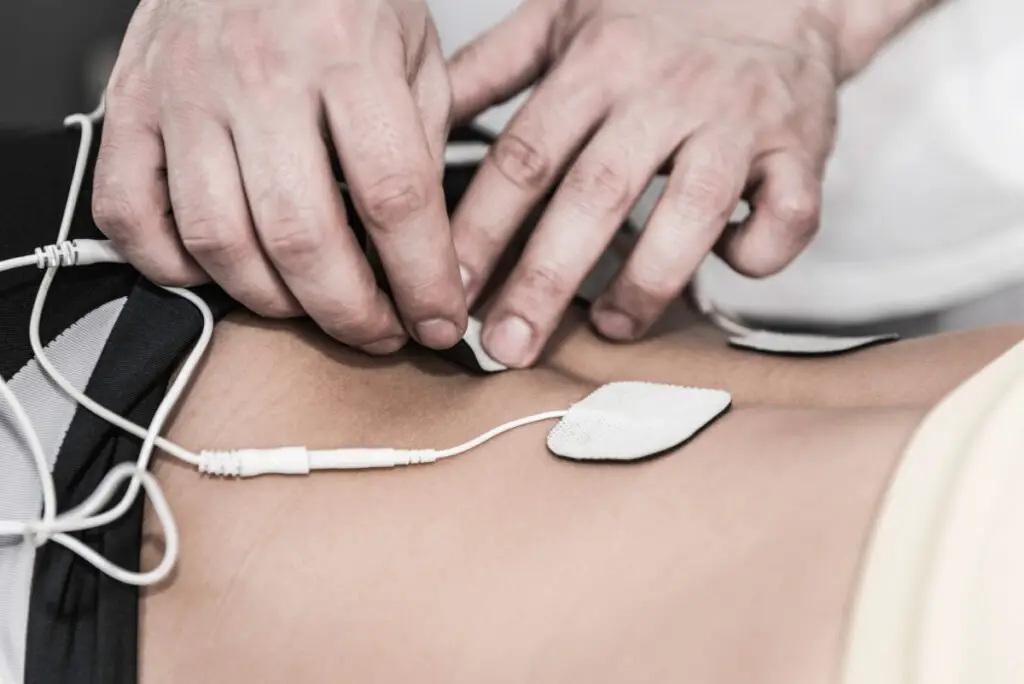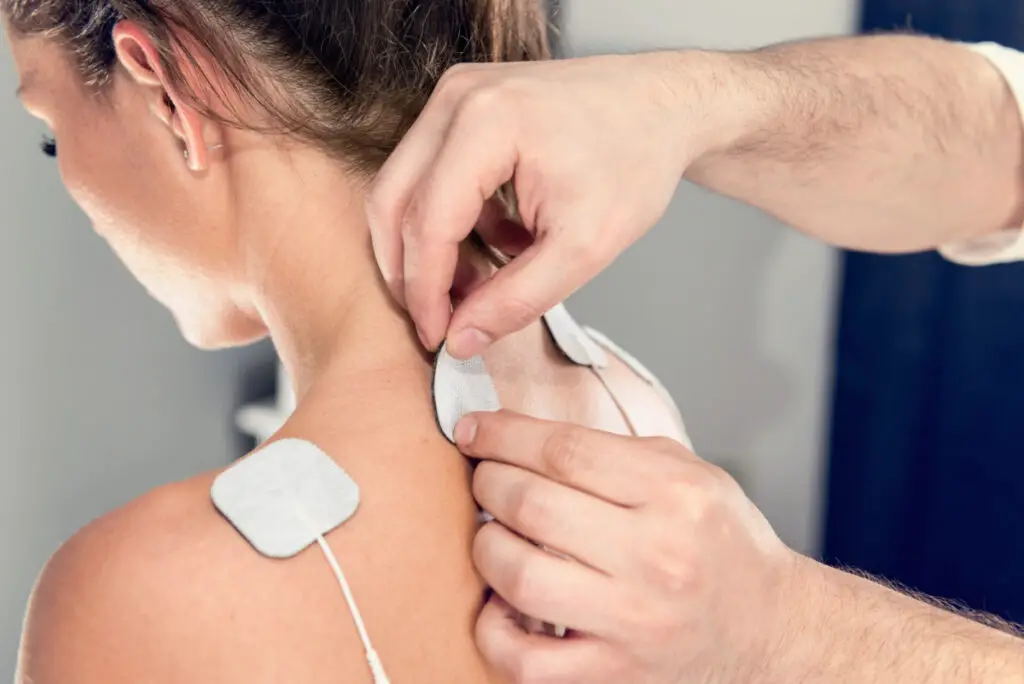Have you ever tried using a TENS unit for pain relief? These electrotherapy devices have become a popular way of providing just that in recent years. They are generally quite safe and useful, and they don’t have the side effects and addiction potential that painkillers have.
If you’ve never used a TENS unit before, then it can all look confusing. A small controller with an octopus of wires, electrodes, etc. Does it hurt? Do you get shocked? It’s a bit daunting!
In this blog post, I’ll go over everything you need to know to get started. Read on to find out how to use a TENS unit for pain relief.
How To Use A TENS Unit

Pain is difficult to deal with, particularly when it’s chronic pain.
TENS (transcutaneous electrical nerve stimulation) units are electrotherapy devices that look a lot like a phone from the early 2000s, with a bunch of wires coming off of it.
They look old-school but are surprisingly effective at helping many people around the world to control their pain from the comfort of their homes. Each wire has an electrode pad attached to it, which sends a mild electrical pulse through the skin. These pluses are designed to block the feeling of pain.
The safety and effectiveness of TENS machines make them a very compelling offering.
You won’t experience any side effects like you can when using painkillers, which many times don’t even work. And there’s no potential for addiction, overdose, and all that.
So, now let’s take a closer look at the time, frequency, electrode pad placement, the various settings, and any precautions that you need to be aware of. You can be assured that you’re using your home TENS unit in the proper way.
How Often Should You Use A TENS Machine?

The timeframe in which you should use your TENS unit to control your pain depends on several factors, including:
- the area of the body where you need relief
- whether the pain is a chronic condition or an acute injury
- the intensity of the setting that you’re using
For example, if you have a chronic pain in your back for example, then you’ll probably want to have a longer session of about 60 minutes on a lower setting to help reduce pain signals. Whereas if you have acute knee pain, you may use a higher intensity for 20 minutes or so to find relief.
See how long can you use a TENS unit for more details.
In general, it is suggested that you can use your TENS unit to control the pain from acute injuries for between 20 and 60 minutes, up to four times a day. For more chronic conditions, shorter timeframes spread out, and adding up to around five hours of use a day are recommended.
However, it should be noted that you should be able to safely use your TENS unit whenever you like, depending on how severe your pain is. Just be aware that you should take breaks between your sessions, so as not to cause any skin irritation where you place the electrodes.
Note that you should always follow the instructions of your individual device.
Where Should I Place The Electrodes?

In general, you should position the electrode pads around the painful area to be treated, although there are certain positions that are proven to provide better results for longer-lasting pain relief. These positionings are as follows:
Knees
If you have knee pain, then placing the electrode pads both above and below the joint, as well as on both sides will help to control your pain issues.
Lower Back
With lower back pain, placing the electrode pads in pairs on both sides of the spine works best. So for instance, if the pain in your lower back is on the right side, position the pads on either side of the site of pain, and then match this position on the other side of the spine.
See also: TENS Unit for Back Pain: TENS Therapy to Relieve Back Pain
Neck
If you have pain in the back of your neck (again, never position the pads on your throat or the sides of your neck), then place a set of electrodes on either side of the back, making sure they’re not touching your spinal column.
See also: How to Use a TENS Unit for Neck Pain
Shoulders
With shoulder pain, you can position a pair of electrodes on each side of the base of the neck, as well as other pairs on the painful spots.
The positioning of the electrode pads, which are self-adhesive and stick to your skin during your session, should be considered carefully before you start your treatment.
You should also be aware that your skin can become irritated from the small electrical impulses. If that happens, you should take a break and then place the pad in a different spot during your next treatment.
Can You Use A TENS Unit On Your Face?
When you have a look at the manufacturer’s recommendations for your TENS unit, you will find a warning that you shouldn’t use the device on your face. And this is for a very good reason.
The electrical pulses from the electrodes are much too strong for your face! Facial skin is very sensitive, and the nerves are closer to your brain. Because of this, your skin will become really irritated if you place the electrodes on your face, and can even cause permanent damage to the facial nerves.
The electrical pulses from the electrodes are much too strong for your face!
It is therefore recommended that you do not place the electrode pads anywhere on either your face, throat, or the sides of your neck. If you want to place the pads on the back of your neck to treat pain, that’s fine, as long as you don’t put them directly on your spinal column.
How High Should I Set My TENS Unit?

Everyone is different, which means that your pain threshold will vary from the next person. This is why setting the intensity of your TENS unit while you’re using it will depend on you and your specific situation.
When you begin your TENS session, you should always set it to zero before turning it on. This will prevent any potential irritation to your skin during the initial process. Once it’s running, you can start to increase the intensity as time goes on.
As long as you’re experiencing tingling that doesn’t hurt or cause your muscles to twitch excessively, then it is fine to increase the setting until you find some relief from your pain.
If you increase the setting and then find that your muscles start twitching, or you feel any discomfort, give your body a break, and turn the machine off.
You can always fire up your TENS unit again later on, in the event that your pain returns and you need some relief.
If you increase the setting and then find that your muscles start twitching, or you feel any discomfort, give your body a break, and turn the machine off.
How To Use TENS Unit Settings
Depending on the TENS unit itself, there will be different settings that correlate to the intensity and frequency of the electrical pulses that are generated, so you should read the manufacturer’s instructions for your specific unit thoroughly to make sure that you use your device correctly.
In general, most TENS units come with three settings, ranging from low frequency (2-10Hz) to high frequency (80-100Hz). The lowest setting is mainly used for stimulating the release of endorphins for those who are dealing with chronic pain conditions.
When you have more acute pain, the high-frequency setting, when used at shorter intervals, will generally provide relief that will last for longer. Some people have reported that they have found relief for up to four hours after a session.
The medium setting (35-50Hz) is the one that causes stimulation the muscles for strengthening, and even relaxation, which is helpful if you have pain from cramps or spasms.
Where Should I Not Use A TENS Unit?
As we’ve already mentioned, using a TENS unit on your face is a definite no-no. But there are a few other places on your body that are also too sensitive to place the electrode pads, and you should be aware of these so that you don’t cause any more damage to your body.
For example, you should never place the electrodes on your chest, or directly on your spine, as we’ve mentioned above. These areas are far too sensitive for direct electrical stimulation and have the potential of causing severe risks to your health.
If you have any skin irritation, including broken or numb skin, or open wounds, then you shouldn’t place the electrodes on these areas. There will be damage to the nerves in these areas already.
You can safely place the electrodes around any wounds, however.
In addition, if there are any parts of the body where you have an infection, such as a cyst or a malignant tumor, then you shouldn’t place the electrodes on these areas, because the electrical pulse has the potential of spreading the infection due to the muscle contractions generated.
As far as hygiene is concerned, you shouldn’t share your electrode pads with others, even family members. You can buy additional pads wherever you purchased your TENS machine, and these will also come in handy when your originals need replacing.
To wrap up, as long as you follow all of these precautions mentioned, then you can safely use your TENS unit without worrying about doing so.
Final Thoughts
As you can now see, there are quite a few factors to consider when you use a TENS unit to help control your pain. But they’re all pretty simple to deal with. As long as you follow the basic instructions, you can rest assured that you have a safe way of easing pain that doesn’t use pharmaceutical painkillers.




